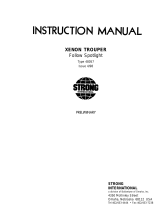
14 Source Four Assembly Guide
Lens Tubes - 19° to 50°
Reference
Number
Part
Number
Description Quantity
Required
1 7060A3169 Lens Tube, left casting, Black (rev. J begins 01/06 to present) 1
2 7060A3171 Lens Tube, right casting, Black (rev J. begins 01/06 to present) 1
3 7060A4077 Aspheric lens, 19° (begins 10/98) 1
4 7060A4001 Aspheric lens, 26° 1
5 7060A4020 Meniscus lens (front), 36° 1
6 7060A4021 Bi-convex lens (back), 36° 1
7 7060A4004 Aspheric lens, 50° 1
8 7060A3079 Clip, gel retainer, 90° bend 1
9 7060A4008-01 Knob set with male insert 1
10 7060A4009 Bushing, guide 8
11 7060A4012 Pad, lens support 5
12 HW3154 Screw, Phillips, 8-32 x 5/8 Taptite 4
13 HW5143 Washer, flat fiber 1
14 HW534 Nut, Hex, 1/4-20, black zinc 2
15 HW750 Spring, retainer 1
16 7060A4033 19° Lens tube label, white text (for black fixtures) 1
17 7060A4034 26° Lens tube label, white text (for black fixtures) 1
18 7060A4035 36° Lens tube label, white text (for black fixtures) 1
19 7060A4036 50° Lens tube label, white text (for black fixtures) 1
20 7060A4073 19° Lens tube label, black text (for white fixtures) 1
21 7060A4074 26° Lens tube label, black text (for white fixtures) 1
22 7060A4075 36° Lens tube label, black text (for white fixtures) 1
23 7060A4076 50° Lens tube label, black text (for white fixtures) 1
Note:
Any part that is indicated as “Black” may be also ordered in white or silver. When
ordering white, use the part number suffix -1, and for silver, use the part number
suffix -5.
12
Figure 14
Note: Lenses are degree
specific. Do not interchange
lenses (i.e. do not place a
19° lens in a 26° slot).
1
2
8
9
10
11
13
14
15
3
4
5
6
7





















